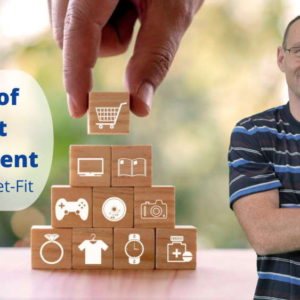Introduction In the realm of smart agents, prompts function as...
Read MoreProduct management is a challenging and critical role in any organization, requiring the art of balancing various factors. As a product manager, the primary objective is to provide a valuable product that meets the needs of the target audience. In a previous article, I introduced my 10 commandments for effective product management.
To recap, these include:
- achieving a Product-Market-Fit,
- communicating with potential clients,
- avoiding asking clients for solutions,
- assembling the right team,
- adopting an agile approach,
- testing assumptions continually,
- ensuring team cohesion,
- creating user-friendly experiences,
- learning from competitors,
- and allocating sufficient resources for deployment.
In this article and the accompanying video, I will delve deeper into my first commandment, which is achieving a Product-Market-Fit (PMF).
What is a Product-Market-Fit
When a Product-Market-Fit (PMF) is achieved, it means that:
- A strong and unbreakable connection has been established between the product and the target customers.
- The product addresses an underserved need, offering a valuable proposition that customers are willing to pay for.
- The correct feature set, wrapped up in a user-friendly experience, solves the identified need for a significant enough customer base.
- However, the most significant challenge facing companies, not just startups, is believing they have achieved a PMF when they have not.
To achieve a PMF, there are two stages in the product’s lifecycle – Before-Product-Market-Fit (BPMF) and After-Product-Market-Fit (APMF). The BPMF stage requires only wild optimism, but the APMF stage demands research, analysis, and hard evidence to confirm that the product indeed fits the market.
Two examples, Spotify and Coke-Cola

Spotify, which was founded in 2006 following the demise of Napster, recognized through shrewd research that people would be willing to pay small fees to “own” music. Their product features and excellent usability were based on extensive user testing, which led to their success in achieving a genuine Product-Market-Fit journey.
Today, Spotify has over 270 million users and is a prime example of PMF done right.
On the other hand, you may have never heard of New-Coke, a product launched in 1985 by Coca-Cola to replace the existing cola brand.
The company had conducted extensive consumer research to create a formula to rival Pepsi’s latest product, which had a sweeter taste. However, the researchers failed to ask the right questions and realize the emotional attachment that consumers had to the original Coca-Cola beverage. This led to a massive customer uproar and a demand that the old product be returned to the shelves. New Coke became a costly case study in launching the wrong product.
Highlighting the importance of achieving a genuine Product-Market-Fit.
What happens when a PMF is not achieved?
Companies often feel the consequences of not achieving a PMF when they enter the market. Difficulties in marketing arise when customers are not enthusiastic about the product. Without product usage, there are no referrals, which is a crucial marketing technique.
Sales cycles become lengthy, and after several months or years, the company may realize that they need to invent or reinvent their PMF, which can be a costly and time-consuming process. If a company has the resources to pivot, then that’s great. However, if not, the startup may close, or the product may fail to take off or reach the market.
How do you achieve a PMF?
To become a domain expert and gain knowledge about your industry and market, start with conducting extensive research both online and offline. This will enable you to become the smartest person in the room. Research other products and solutions, as well as your competitors. You can learn a lot from your competition, but this will be discussed in future articles.
Next, create a client persona based on your online research, and then begin the challenging but intriguing part of your journey, which involves seeking out potential clients and talking to them. Conducting interviews is an essential topic that deserves a dedicated article. This article should cover how to conduct interviews, what questions you should and shouldn’t ask, and how to perform the necessary analytics.
Interviews
Don’t hesitate to approach potential clients and value their opinions. In some areas, such as Silicon Valley, it’s common to interview clients and people are generally open to it.
Conduct online or face-to-face interviews with at least 10-20 people, depending on the type of business and product.
At least 60-70% of the interviewees should have a strong need for your solution, indicating potential for a successful business. If not, pivot and consider creating a new client persona or interviewing a different set of people.
Repeat this process throughout the product’s lifecycle to stay dynamic and responsive to changes. Use feedback to pivot product features and act quickly based on gathered intel.

Building your MVPs
After specifying your product development roadmap, it’s time to determine the minimum-viable-product (MVP) features and begin developing the first MVP. Once the MVP is ready, return to the customers you interviewed and test it with them through usability tests and surveys. This will help you determine if you’re headed in the right direction or need to pivot.
However, it’s important to note that you won’t know for sure if you have achieved PMF until you reach the market and start getting paying clients. But by following a lean, agile, and robust methodology, you increase your likelihood of success tenfold.
Case study #1 - The BIG Short (2015)
One of my favorite films, the BIG short, tells the story of the housing market meltdown in 2008 and highlights three entities (actually four) that predicted it, bet against the housing market, and profited greatly. Among them was FrontPoint, a small investment firm led by Mark Baum (played by Steve Eisman), which used a unique method to identify the PMF of the product they invested in (shorts on housing bonds).

The “Pitch”
Jared Vennett, a banker from Deutsche Bank, stumbled upon a new idea of shorting the housing market when he discovered that only a few people were concerned about the housing market being in a bubble. He invested in this product and attempted to share the risks by offering a partnership to his colleagues, who laughed at him and refused. By chance, he dialed a wrong number and ended up pitching his idea to FrontPoint.
Falling in-love in your idea
Mark Baum, the FrontPoint manager, is highly biased towards the idea of shorting the housing market due to his disdain for the banking and financial system.
This presents a common problem with startup founders who can become emotionally attached to their ideas and fail to conduct objective testing. Fortunately, Mark’s team recognizes his bias and encourages him to validate the idea through stakeholder and expert interviews.
Mark devises a simple method to answer two key questions to validate the existence of a housing bubble and the potential value of the investment product. This approach exemplifies the importance of conducting a rigorous PMF validation process, even when strongly believing in a product or idea, to gather robust evidence and convert beliefs into facts.
Validation
Mark and his team embark on a trip to Florida to conduct interviews with a diverse group of stakeholders, practitioners, and clients in the housing business, including a stripper, to validate their idea. Instead of trying to sell their idea, they ask the right questions to understand the state of the housing market from the stakeholders’ point of view.
After a lengthy process of evidence gathering and interviews, they confirm that the housing market is on the verge of crashing and that shorting the housing market is a lucrative opportunity. Only after they have validated the product-market-fit do they decide to invest.
Even after FrontPoint invests, they remain uncertain about the validity of their PMF. Mark continues to validate the product throughout its life cycle to strengthen their position and ensure that significant market changes do not invalidate their product-market-fit.
Mark’s actions demonstrate that PMF exploration is an ongoing process that must continue to evolve and mature since market conditions change, and product development is a dynamic process.
The endgame
The process was a lengthy and high-stakes endeavor, but it eventually proved successful. After several years, FrontPoint was able to sell its entire short position and earn a significant profit.
Despite validating the PMF, Mark and his team still harbored doubts, unsure if they may have missed something and were incorrect while others were right. In the end, only the outcome and results proved their hypothesis.
If you’re interested in seeing the movie, I highly recommend it. The trailer is provided below. You can also view all the scenes related to this case study in the video lecture I provided earlier.
Case study #1 summary
This case study showcases a unique example of the product creation process, given the backdrop of the 2008 financial crisis and the housing market meltdown. Despite the crisis, the story illustrates the importance of creating a new product (shorts on the housing market) and validating its Product-Market-Fit (PMF).
The key takeaways from the case study include:
- The recognition of a need or market condition, extensive research and analysis,
- PMF validation through footwork and evidence gathering,
- Ongoing PMF refinement,
- Adaptation to changing market conditions,
- The importance of measuring the outcome through product sales.
Overall, the case study provides valuable insights into the PMF process and highlights the importance of rigorous testing and validation of new product ideas.
Case study #2| Dgen – reliable big data for machine learning.
We will conduct a second exercise on PMF creation, which will be brief and not cover the entire process. Nonetheless, it will offer you a glimpse of how the process works. Please note that the data provided in this example has not been tested or validated and is purely for the purpose of this case study.
Let us start by outlining the problem and proposed solution:
As a scientist and a practitioner of machine and deep learning in the automotive industry, I encounter a significant challenge while researching NLP and computer vision technologies. It consumes a lot of time to search and generate useful and reliable data for training and testing models, whether labeled or not.
I have an excellent idea for software that automatically generates databases. The machine learning practitioner describes the dataset and its parameters, and the software scrapes the internet to create the dataset automatically.
Does this sound like a great idea for a startup? Perhaps…

Dgen Product-Market-Fit journey begins...
To start my PMF journey, I conducted extensive online research into the market, products, technologies, competitors, and business strategies. Then, I calculated my total available market and created my perceived client personas, which were data scientists and machine learning practitioners working in SMBs and mid-to-large size organizations, with a focus on the fintech or medical devices sectors.
Initially, I focused on the fintech sector and interviewed 20 scientists. However, the results were not positive as 12 of them reported an abundance of reliable data that was well-structured and labeled, with simple APIs available and manageable dataset costs. Therefore, it appeared that there was no actual need for my solution, indicating a lack of Product-Market-Fit.
Share of market (SAM)
Continuing my PMF journey, I move on to the medical devices sector and interview 20 MD scientists.
Out of them, 15 report that obtaining data is a major challenge due to various factors such as scattered data across multiple databases, data being unreliable, lack of labeling standards, and difficulties arising from GDPR and privacy concerns.
From these findings, it appears that there is a significant need for a solution in this sector.
Serviceable Obtainable Market (SOM)
After narrowing down the market size to companies that offer solutions for heart-related issues, I discovered through research and consultations with leading physicians and ML practitioners that there are no dependable and universal data sources available. The data is specific to each case and needs to be collected through clinical trials.
As a result, our solution, no matter how promising it is, is not a fit for this sector.
Pivoting
Continuing my research, I shift my focus to companies that offer solutions for breast cancer patients. After conducting interviews with relevant stakeholders, I discovered the following:
- There are many companies working on developing solutions for early detection of breast cancer.
- The market is sizable and companies are looking for more advanced products based on machine learning (ML) and deep learning (DL).
- However, finding and creating reliable datasets for research, training, testing, and production is challenging.
- Although the data exists, it is unstructured and scattered with no centralized collection system.
It appears that we have found our niche and achieved Product-Market-Fit.

Going deep
I conduct a new series of interviews to create my client personas and to collect more hard evidence that will justify my assumptions and strengthen the PMF. However, during extensive research, I find out that the practitioners and scientists which are the definite users of our system are not the decision makers. And actually, the budget for the solution, I am about to offer, is not even from R&D departments…
I conduct a new round of interviews to refine my client personas and gather more evidence to support my assumptions and strengthen the PMF. However, my extensive research reveals that the practitioners and scientists who will definitely use our system are not the decision-makers, and the budget for the solution I am proposing does not come from the R&D departments.
Although the process of achieving a reliable product-market fit can be lengthy and at times tedious, it is a critical milestone in our product journey – one that we must reach before moving on to the development stage. It is also a step that we will revisit once our first MVP is ready, as we continue to cycle through the stages of product development.
Case study #2 | Dgen summary
This case study on Dgen highlights the process of achieving a PMF.
- It began with the identification of a personal problem and a few assumptions for the required need.
- An initial solution was suggested, and intensive research was conducted on the tech, market, and business aspects.
- This helped in creating accurate client personas and identifying potential clients.
- Clients were interviewed to gather strong evidence and understand the serviceable market.
- After some exploration and pivoting, an accurate client persona and serviceable market were identified, revealing the paying clients/decision makers and methods to create revenues.
This process can be customized to your specific needs and requirements, depending on your industry, market, and product.
Summary and conclusion
The objective of this article is to emphasize the importance of Product-Market-Fit (PMF) exploration, which is the most significant “commandment” in creating a successful product and business. It should be noted that this process is not limited to technical products and can be adapted to any type of product or service with appropriate modifications.
PMF is the process of establishing an unbreakable connection between a customer need, a solution that fulfills that need, and a willingness to pay for that solution. It is critical to identify a PMF as early as possible in the product journey to save time, money, and, in most cases, determine the difference between success and failure. Achieving a PMF entails a rigorous process of research, customer interviews, collection of hard evidence, testing of assumptions, and, if necessary, pivoting.
PMF exploration is a continuous process that should be repeated throughout the product’s life cycle.
My name is Avidor, and I am an experienced product manager. If you have any questions or require consultation, please contact me at avidor@ioteratech.com.
More Posts
Unleashing the Future: Crafting Your Very Own Smart Agents
Introduction As we witness the rapid evolution of artificial intelligence...
Read MoreMy first commandment for product manager – Product-Market-Fit
My first commandment for product manager Product-Market-Fit Last Updated: 16...
Read More


